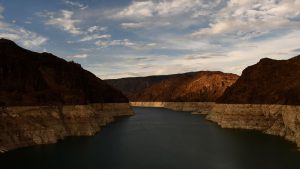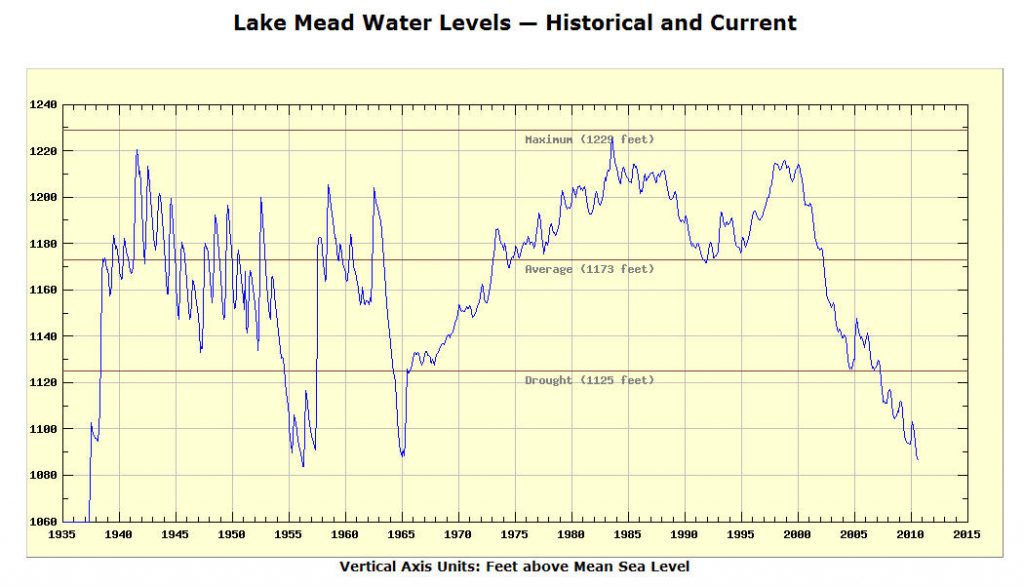Lake Mead and the people it supplies with water are in trouble. According to Axios, “For the first time since its construction in the 1930s, the federal government has formally declared a water shortage at Lake Mead, the nation’s largest reservoir by volume, on the Colorado River.” As a result of this declaration, which was issued by the Bureau of Reclamation, there will be a series of water allocation cuts to downstream states along the Colorado River.
As reported by MSM, “Lake Mead will be under a Tier 1 shortage, meaning that starting next year, Arizona will receive about 18% less water from the Colorado River than in a typical year” while “Nevada’s water allowance will be reduced by about 7%, and Mexico’s by about 5%.”
Due to a severe and prolonged drought, the water level of Lake Mead is at 1,067.74 feet, which is 161.26 feet below a full pool level of 1,229.00 feet, according to lakesonline.com. This is the “lowest level since the lake was created with the damming of the Colorado River in 1935” as reported by ABC News.

As a point of comparison, when completely full, Lake Mead would cover the top of the Empire State Building, which stands at 1,250 feet. At its current level, the top 18 stories of the famous Manhattan skyscraper would stick out of the water.
Compounding problems is the ongoing, high demand for waters from the Colorado River. According to the U.S. Geological Survey, “Categories of water use include public supply, domestic, commercial, industrial, irrigation, livestock, mining, aquaculture, hydroelectric, and thermoelectric power generation, and wastewater returns.” Over time, the breadth and depth of these demands put a strain on the river’s capacity. Kathryn Sorensen, former director of water services in Phoenix and now with Arizona State University stated recently that “The Colorado River is over-allocated. We really can’t rely on snowpack in the Rockies to refill our reservoirs and mitigate the over-allocation of the river.”

A graph of water levels of Lake Mead since 1950. I
Source: www.dailymail.co.uk
This is causing concern among experts. Doug Hendrix, the public affairs specialist for the Lower Colorado Basin for the U.S. Bureau of Reclamation, stated, “We’d like to see it entirely full. The last time the reservoir was entirely full was in the late 1990s, around 1998,” adding “The Colorado River is the lifeblood for about 40 million people in the southwest including northern Mexico. Under full reservoir operations, we can generate enough power annually for about 600,000 households. Now we’re down to be able to generate power for about 450,000 households.”
This is because hydroelectric power is directly tied to water levels, especially with regard to Hoover Powerplant. As the Las Vegas Sun reports, “Five of the 17 main hydraulic turbines at the Hoover Powerplant have been replaced in recent years with more efficient models. Without the turbine upgrades, the plant would have been less than two years away from not having enough water to operate. The turbines are the core of one of the largest hydroelectric plants in the nation, producing enough power to serve 1.3 million people a year in Nevada, Arizona and California.” The grim reality is that if water levels keep dipping, the turbine may not be able to generate electricity, potentially resulting in rolling blackouts.
Echoing these concerns, Assistant Secretary for Water and Science Tanya Trujillo said in a statement, “Like much of the West, and across our connected basins, the Colorado River is facing unprecedented and accelerating challenges. The only way to address these challenges and climate change is to utilize the best available science and to work cooperatively across the landscapes and communities that rely on the Colorado River.”
The reality is that problems with the Colorado River have been building for quite some time. But, much like everything else in our country, we tend to delay action until we reach a crises mode.
As John Fleck, director of the University of New Mexico’s Water Resources Program frames it, “Politicians in the 1920s ignored science and promised more water to the cities and farms of the west than the river can deliver. So we’d be in trouble even without climate change. But warming temperatures are making the problem worse, by increasing evaporation so less water can make it downstream to users.”
The governors of the affected state apparently also understand the urgency of the matter. As Reuters reported, “Separately, 10 Western governors urged President Joe Biden to declare a federal drought disaster in their states, qualifying farmers and ranchers to seek special assistance “beyond what is available through existing emergency programs.” The governors also pleaded that “Historic drought levels threaten to eliminate entire crops, depress yields and harbor extreme levels of pests and disease that add to the cumulative loss.”
The letter highlights the idea of the interconnectedness and interplay of a wide variety of systems. Any disturbance or disruption in these systems, such as a severe drought, causes a cascade of causes and effects. As a recent post by Bentoli, a developer, manufacturer, and distributor of animal feed additives states, “. . . the agriculture industry relies heavily on irrigation that in turn relies on State and Federal water projects that transport water hundreds of miles. When one part of the chain is affected the entire industry feels the effects.”
All may not be lost, however. As MSM reports, “The Bureau of Reclamation estimates that normal snowfall in the Rockies and the Upper Basin this winter will reverse the present drought. By the end of September 2022, the agency expects the river to bring 8.3 million acre-feet of water into Lake Powell, the reservoir on the Utah-Arizona border that precedes Lake Mead.”
And U.S. Bureau of Reclamation spokeswoman Patti Aaron said, “We’re expecting the reservoir to keep declining until November, then it should start to rebound,” adding “We are concerned, but it isn’t a crisis. People have been planning for this moment for a long time and have the mechanisms in place to protect the water levels at Lake Mead.”
But not everyone is so optimistic about the future. As Fleck warns, “There’s a risk when [water managers] cling to the hope of a big snowpack bailing us out. We need to recognize that there’s going to be less water to work with.”
With winter several months away, if there was ever a time to pray for snow, it’s now.
At Newsweed.com, we adhere to three simple principles: truth, balance, and relatability. Our articles, podcasts, and videos strive to present content in an accurate, fair, yet compelling and timely manner. We avoid pushing personal or ideological agendas because our only agenda is creating quality content for our audience, whom we are here to serve. That is why our motto is ”Rolling with the times, straining for the truth.”
Your opinion matters. Please share your thoughts in our survey so that Newsweed can better serve you.
Charles Bukowski, the Los Angeles beat poet that captured the depravity of American urban life once said, “There is something about writing poetry that brings a man close to the cliff’s edge.” Newsweed is proud to stand in solidarity and offer you a chance to get close to the cliff’s edge with our first Power of Poetry Contest. Are you a budding bard, a versatile versifier, a rhyming regaler? Do you march to the beat of iambic pentameter, or flow like a river with free verse? If so, here’s your opportunity to put your mad poetic chops to the test. Enter our poetry contest for bragging rights and an opportunity to win some cash!






